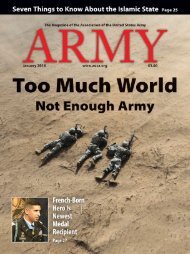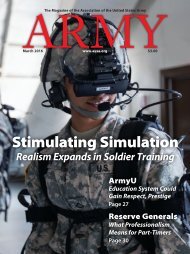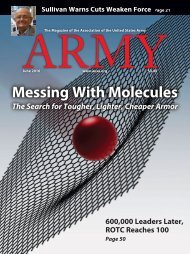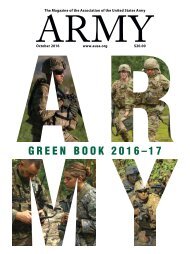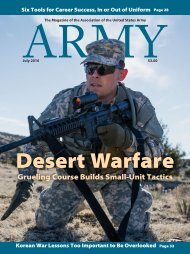Army - Kicking Tires On Jltv
Create successful ePaper yourself
Turn your PDF publications into a flip-book with our unique Google optimized e-Paper software.
U.S. <strong>Army</strong>/Sgt. Cheryl Cox<br />
built, to allow for immediate and collaborative Mission Command<br />
with Gulf Cooperation countries and long-standing allies<br />
such as Great Britain, Canada, New Zealand, Australia<br />
and France. This concept proved prescient in late spring 2014.<br />
When the situation in Iraq reached crisis status in June<br />
2014, the national command authority directed U.S. Central<br />
Command to commence military operations against the Islamic<br />
State group, known throughout the region as Daesh.<br />
U.S. <strong>Army</strong> Central was designated the joint force land component<br />
commander for operations in Iraq. Having matured<br />
since the inception of the regional security plan in late 2011,<br />
forces immediately available, including the robust theater architecture<br />
established by the enabling commands, allowed for<br />
rapid transition from Phase 0 focused activities.<br />
The joint force provided its own contributions, including a<br />
Special Purpose Marine Air Ground Task Force, U.S. Naval<br />
Forces Central Command’s Fleet Anti-Terrorism Response<br />
Team and a special operations forces crisis-response element.<br />
This combination of capabilities allowed the joint force land<br />
component commander to move rapidly into Iraq with the appropriate<br />
Mission Command, security and sustainment capabilities<br />
to make initial assessments and provide assistance to<br />
Iraqi security forces. The joint force land component commander<br />
also had reach-back capability that included longrange<br />
fires and myriad sustainment functions.<br />
Challenges Expanded<br />
As allies and partner nations communicated their desires to<br />
contribute capabilities, U.S. Central Command designated the<br />
joint force land component commander as the combined force<br />
land component command on Sept. 17, 2014. This expanded<br />
the number of challenges facing the headquarters as it had to<br />
integrate coalition capabilities while simultaneously establishing<br />
Mission Command system networks to support multinational<br />
collaboration.<br />
Recognizing that operations against Daesh required full<br />
joint integration, U.S. Central Command further designated<br />
the combined force land component command as a combined<br />
joint task force (CJTF) on Oct. 17, 2014, and eventually settled<br />
on the designation “CJTF-Operation Inherent Resolve.”<br />
To staff the CJTF, the combined force land component command<br />
staff developed and submitted completed joint staffing<br />
documents.<br />
The time frame from document submission until capability<br />
was in place was anticipated at secretary of defense approval<br />
plus 120 days. To mitigate this gap, U.S. <strong>Army</strong> Central was<br />
able to work with the other U.S. Central Command service<br />
components in theater—another <strong>Army</strong> service component<br />
command standing relationship that proved vital—to assist<br />
with joint fills until the respective service headquarters could<br />
assess and fulfill their requirements. U.S. <strong>Army</strong> Central also<br />
requested and received augmentation from the Joint Enabling<br />
Capabilities Command and the Joint Intelligence Support Element,<br />
which provided significant assistance with joint functions<br />
and capabilities oversight.<br />
Today, U.S. <strong>Army</strong> Central retains the designation of combined<br />
force land component command for operations in the<br />
joint operations area, while a corps headquarters serves as the<br />
CJTF-Operation Inherent Resolve headquarters. From the<br />
start of operations against Daesh until the deployment of III<br />
Corps, 15 months had passed in which U.S. <strong>Army</strong> Central<br />
served dual-hatted as a combined force land component command<br />
and CJTF-Operation Inherent Resolve, while continuing<br />
to accomplish its missions as an <strong>Army</strong> service component<br />
command on behalf of the secretary of<br />
the <strong>Army</strong>. No other command echelon<br />
has the depth and versatility to simultaneously<br />
perform these functions.<br />
U.S. <strong>Army</strong> Central has served as the<br />
land component command providing<br />
Mission Command for land operations<br />
in the U.S. Central Command area of<br />
responsibility three times since 2001.<br />
Based on this historical precedent as well<br />
as lessons learned in recent contingency<br />
operations in Iraq, the combatant commander<br />
needs an immediately available<br />
joint and coalition capability and the<br />
theater-enabling capability inherent in<br />
the <strong>Army</strong> service component command<br />
to mitigate delays in responding to crises<br />
and contingencies. The <strong>Army</strong> service<br />
component command or theater <strong>Army</strong>,<br />
embedded in the theater and with persistent<br />
presence and enduring partnerships,<br />
provides that capability. ✭<br />
Pfc. Morgan Calebrese, an engineer with the<br />
244th Engineer Battalion, teaches Iraqi soldiers<br />
about the armored bulldozer.<br />
February 2016 ■ ARMY 51




